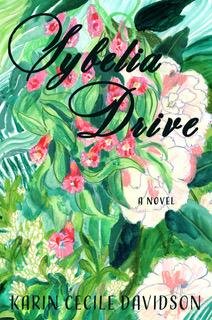
The following is a conversation with Karin Cecile Davidson, whose first novel, Sybelia Drive, is being published this fall by Braddock Avenue Books (October 6th).
Sybelia Drive is a Vietnam-era novel that tells the coming-of-age story of brother and sister Lulu and Saul, and their friend Rainey, who lives with them as a de facto sister while her absent mother seeks the dubious rewards of a Gypsy Rose Lee-type fame and fortune. In a lush but depressed lake town of Florida, family members and townsfolk take turns filling in their own stories, as well as the fates of those who left for Vietnam only to be killed, go missing, or return physically and psychologically changed forever. The resulting kaleidoscope results in, as the New York Times best-selling author Margot Livesey says, a “morally complex” and “stunning debut.”
Nancy Zafris: You’ve published quite a few stories and won awards, but this is your first published book. What are the good things about publishing a book in middle age, and what are the not-so-good?
Karin Cecile Davidson: It’s strange, somewhat surreal actually. It’s amazing and, to be honest, maddening. But there’s perspective at this point, isn’t there?
I look back at that time in my twenties and thirties when literary and academic opportunities just didn’t work out. At the same time, I was living, traveling, working insanely colorful jobs—river-rafting in the Grand Canyon, working in the kitchens of New Orleans restaurants, butchering Dungeness crabs in Alaska, leading tours in Berlin. And all the while, I was writing. I had babies, and still, I wrote. On slips of paper, in little notebooks I kept in the car, scribbling down anything that came to mind at traffic lights, in parking lots. There’s a lot of garbage one has to write before the stories worth keeping finally show up. So, yes, it’s taken a while, but I’m accustomed to that. Most everything in my world has come slowly, in its own time. I’m essentially still a southerner, though. I’m fine with strolling, porch-sitting, all that languid behavior.
NZ: During this long journey you’ve been on both sides of the transom. You’ve been rejected your fair share, but you’ve also had to reject in your work as an editor for Narrative. How does that temper the discouragement factor that can sometimes get overwhelming?
KCD: I learned, as an editor, that slightly less than ten percent of submissions were promoted, and then take that down several percentage points more to the stories actually accepted for publication. With this in mind, as a writer, receiving mounds of rejections, waiting and waiting for each story to land in the right editor’s hands, I became very patient and incredibly tenacious. It’s one thing to understand how subjective the nature of this business is, and it’s another to remain resilient, sending stories out again as soon as the just doesn’t fit our needs responses come in. From those experiences of receiving form responses, I learned to love the positive rejections. Especially the one from Roxane Gay, back when she was the fiction editor at PANK. She loved a character in a story that only months later won the Waasmode Prize at Passages North. A moment of recognition, even inside the no, thank you, is wildly encouraging.
NZ: So true. But when it takes that much effort to publish a story, holding a full novel manuscript in your hands must have been exhilarating as well as frightening since now the odds for publication are even more stacked against you.
KCD: When Sybelia Drive was complete, I remembered all of this through the long process of querying agents and submitting to novel contests, interest and attention breezing past as those loved it, but good luck placing the book elsewhere comments arrived. Even the finalist recognitions gave me the sense of being the bridesmaid who once again can’t even catch the damned bouquet. Then comes the day, standing under the trees at the Sewanee Writers’ Conference when your future publisher introduces you to your future agent, and in time, everything lands in place. I’ve considered that afternoon again and again, and in the end, this debut novel—forthcoming in a pandemic and in an especially contentious presidential election season—will land in readers’ hands right when it should. And that’s just fine.
NZ: You’ve spent quite a few years being what I call a good literary citizen. Tell me about that a little bit.
KCD: Maybe my beginnings set this course for me, acts of generosity as the foundation from which to find footing and then to push off. The way my grandmother taught me to water the roots of her Florida azaleas, to give them a good long drink. The way as kids we caught perch from the dock on Lake Osceola, then carefully unhooked them, and slipped them back into the water, their silver-gray shapes gone in seconds. The way the first New Orleans chef to hire me rewarded his kitchen staff with steak fries laced in béchamel sauce at the end of our shifts.
To me, it’s the same with the literary life. Acts of generosity, whether exchanging work with a fellow writer or collaborating or working as an editor at a literary magazine, are necessary. Writing workshops are perfect examples; wherein, the giving precedes the taking. Attending readings, buying small press books, supporting bookshops and not warehouses like Amazon, reading through slush piles as a volunteer editor and managing a team of editors at Narrative, interviewing authors about their writing at Newfound, acknowledging the work of contest judges and lit review editors, and thanking everyone who has ever accepted or awarded your work. The literary community is vast, and the competition may feel even wider. Instead of wrestling with feelings of incompetence or insecurity, however, it just makes more sense to create conversation.
NZ: Let’s dive into the book itself. What drew you to this cast of characters and this time period and this small town in Florida?
KCD: A question I’d had for a long time kept rattling around, and when the U.S. became involved in Afghanistan and Iraq, it became louder, demanding an answer. Early on, I lived in a small college town in Florida with tree-lined streets and a lacework of lakes, most of them connected by canals. The war in Vietnam was happening, and a large part of the community was affected. Later, as a teenager, I met young men not much older than myself, who had recently returned from a tour with the Army or the Marines. They were quiet, a kind of unexplainable quiet, never talking about what they’d been through, always thoughtful.
My question had to do with their immense silence. And it also had to do with something a friend and I witnessed as children one morning around the corner from her house. A woman in her bathrobe stood in her carport, wailing and crying and showering the driveway with crystal wine glasses, pretty teacups and saucers, small glass figurines, practically shattering them to powder. This was 1967. Out of silence and shattered glass came LuLu and her friend Rainey and her brother Saul. Their story was complicated, created out of war, the many voices of the period requiring a chance to be heard. Royal, Minnie, Eva, Lillian, and Hélène came forward with their own stories, establishing the interwoven voices of the novel. The small Florida town takes the foreground with war as backdrop, peripheral but no less weighted, as essentially, war decides the novel’s terms, the cause and effect of each chapter.
NZ: Although the book is clearly not autobiographical, what type of memories did you rely on for a story that takes place in the lake country of Florida in the mid-60s? That is, it’s not far enough in the past to be extinct history, brought to life solely by research, yet neither is it a recent enough time period to be a childhood recounting.
KCD: The fictional town of Anna Clara was conceived from memories of Winter Park, Florida. Central Florida. Rollins College. Lakes named Faith and Hope and Virginia.
In creating scenes for Sybelia Drive, I reached toward sense of place. Florida is, of course, lush with flora—open-fingered palm fronds suited to withstand winds, cypresses rising straight out of the lakes, live oaks casting a yard’s worth of shade. Another layer of memory arrives out of sensory perspective of place, of orange groves, the tang of citrus in the trees and rotting on the ground, the sandy yet loamy soil that surrounded the tree roots, the sweet cloying waft of orange blossoms. The singular sight of a heron overhead, the soft repetitive sound of a canoe paddle as it dips again and again into the gray-green lake, the whine of a Volkswagen bus turning the corner and heading away, the drift of Dusty Springfield’s voice from a transistor radio on a kitchen windowsill, the promise of community as the searing aroma of bucket steaks scents the evening.
Grandparents were around then, and neighbors with motorboats, their teenaged kids on water-skis scoring the lake’s surface. The water was clear, minnows easy to catch, the dock speckled with tiny white frog eggs. We were children; we didn’t listen to the news; we only knew of a greater world from our grandparents’ photograph albums and Rudyard Kipling’s Just So Stories. Nonetheless, U.S. presence in Vietnam was already happening, and soon enough the nightly news became weighted with body counts, created, I would learn later, from the worst kind of foreign policy.
NZ: Well, you mentioned Dusty Springfield and this brings up for me the music that filters through your novel. Although Sybelia Drive takes place during the ’60s and early ’70s, the music and musicians who are mentioned are still relevant today—songs we continue to enjoy in rerun or in new covers, musicians like Elton John who are still touring or having recent biopics made of them. Strangely, despite these sensory links to today, the world you’ve created feels so distant, so much of another time. And in thinking about this and why, I landed upon the possibility of the cell phone. Your narrative, as pre-internet, shares a rhythm and languor and community that evokes an earlier time even as it remains recognizably contemporary. Do you have thoughts about how narrative has changed in the world of instant communication?
KCD: The world runs at a completely different speed these days. I remember driving on highways in the early 2000s, the landscape a blur, thinking that I lived in the wrong century. This one was too fast, too sudden, overwhelming. I should have been born in the 1800s, getting from here to there on horseback or by bicycle or on foot.
I do miss the simplicity of a telephone that’s just used for conversations, where you have to sit or stand or lie in one place to talk to the person on the other end, the coiled connection between receiver and telephone stretching and twisting between the fingers. The sensory feel of dialing, the sound of static acknowledging the distance between callers, the act of setting the receiver back in the cradle at the end of a call. Calling someone was a more leisurely undertaking. It took a moment or more just to initiate the call. Like with Eva’s bright yellow telephone, its rotary dial, slowly spinning, one number at a time, and its ring as sunny and bright as its shade.
NZ: Your description makes me picture my grandmother and the straight-back chair next to her phone. I can hear her throat clearing before answering the phone, and I can see her slip off the earring of the lobe that would be pressed to the receiver. Leisurely, sensual, involved. It wasn’t a cursory text message, was it?
KCD: I do think all the immediacy that technology creates has immensely changed the way we tell stories. Six-word stories and iStories, sure; flash fiction, fine; meta-fiction created out of footnotes or postscripts or grocery lists, right. I worry, though, about short attention spans, social media moments like sound bites, so clever and yet so incomplete. Smart phones have definitely changed the way we communicate, their rate and range of information dizzying. Would my novel’s character Lillian Walbright have carried over the ice cream bucket in the pitch of early morning if she’d had a cell phone and Royal’s number in her contacts? Would LuLu have traipsed and spied on the neighborhood by night if she could have stayed in bed and crept on her classmates’ Facebook pages? Rainey might have ignored the light of LuLu’s screen by tenting herself under the covers, her ear buds planted and her Spotify playing Cream’s White Room.
NZ: Yes. The characters in your novel, especially the children, are explorers, physical explorers. Something else you said earlier also struck me: that your question about the soldiers returning from their tours had to do with their immense silence. The lack of instant connectivity (from a 2020 standpoint) lends an aloneness to your characters, despite their multitude, despite their strong, unapologetic voices. Vietnam permeates this world, but in a quiet way. The dead stay quiet, the grief is quiet and lonely, the hopes and future dreams of Lulu and Rainey, the two girls who are the main narrators, keep their own individual lonely vigils. There’s no social media community to keep the dead ever alive, to magnify the singleness of an individual life. Vietnam seems closer to World War II than Afghanistan in that sense. The soldiers trudge home as individuals with no chance of going viral.
KCD: It’s true. There is quietude among the characters, and below that quiet is a vibration of individual desires, unease, determination, hope, and strength. LuLu from the age of nine through her early twenties is perhaps one of the most determined of the novel. Her sense about quiet is to disturb it, mess it up, make it hers. Rainey, more subdued than LuLu, moves through the world in very different ways, her surface calm extraordinary and her hidden strength unwavering. Minnie, Eva, Lillian, Vita are women who hold life together, just as they fall apart, never showing weakness, always reaching beyond what’s expected of them. And those who return changed—Royal, James—and those who don’t return—Alan, Will, Titus—demand nothing. They’ve served their country, unacknowledged, even shamed, and the returned only wish to live on, to be loved, while the dead remain in memory. Yusef Komunyakaa’s poem A Greenness Taller Than Gods expresses this more completely: “We move like a platoon of silhouettes / balancing sledge hammers on our heads, / unaware our shadows have untied / from us, wandered off / & gotten lost.”
NZ: Returning to the motif of music in Sybelia Drive, I noticed that one of the musicians not mentioned in your novel is Paul Simon, not surprising since his type of New York intelligentsia soul-searching evokes a type of privileged aesthetic that might feel foreign in this struggling, small-town demographic. Yet—and this might seem weird—I kept thinking of the early songs of Paul Simon while reading your book. The novel is very lyrical and its very expressiveness began to remind me of the highly poetic Simon and Garfunkel compositions of the mid-60s like The Sound of Silence and The Dangling Conversation, but the song I thought of most was America, about Simon’s road trip with his girlfriend to find America. He says that he is lost and that “I’m empty and aching and I don’t know why.” Simon here is boarding a Greyhound bus and counting the cars on the New Jersey Turnpike, so one thing that wasn’t happening in the landscape of this inward song about personal discovery was the Vietnam War. And if Vietnam were to make an appearance, we can be sure what anti-war posture would be taken. Something remarkable about your book is how the Vietnam War just is, how it’s part of the fabric of the lyrical inward personal journeys of your characters who are also aching and empty and don’t know why, and who express themselves in lyrical terms. It feels almost as if I’m reading the southern/Floridian version of a Paul Simon song. Am I off-base here?
KCD: I love that your thoughts traveled to Paul Simon’s early songs. Sybelia Drive’s lyricism certainly arrived out of decades of listening, my mother’s 1960s record collection a major influence. Simon and Garfunkel came our way in 1968 via the movie soundtrack to The Graduate. Bookends showed up next, an album for which the stereo arm was left open, allowing that side to play repeatedly. The songs possessed an honest sort of questioning, a kind of searching that called to me—America, Old Friends, A Hazy Shade of Winter. Not typically something a child would listen to or like. I suppose these lyrics and their arrangements, their striking tonalities, shaped my sense of language in a way. I’m sure they did.
The lyrics of Simon’s America remind me of all the characters of the novel’s Lake Sybelia community, but especially of LuLu’s brother, Saul, and his tender obsession with Rainey. So many of that song’s lines could be his thoughts. When I was thinking about the early interlude chapter in which Mrs. Wild, the elementary school principal, is watching LuLu and Rainey on the playground outside her office window, the quiet guitar and phrasing of Simon and Garfunkel’s Bookends Theme came to mind. The intro to that song is sharply pitched and then softens into the briefest moment of harmonizing and nostalgia. In the playlist I assembled and relied on for this novel, Paul Simon was always in the background, and music of the era became extremely important in relating the characters’ individual stories. Percy Sledge, Dionne Warwick, Dusty Springfield, Frank Sinatra, The Beatles, Buffalo Springfield, Cream, Jimi Hendrix, Elton John, Pink Floyd, The Rolling Stones—the music of the novel is one of that era, whether playing on the Blackwoods’ VW Bus radio or in the minds of the men in Royal’s squad in Vinh An.
I hope this listening I’ve done in my life helped me tell this story—which I think is a southern one, and at the same time universal to those affected by war, whether in uniform or back at home—in a way that acknowledges a part of our history that, still now, contains so many questions.
NZ: Thank you so much, Karin, for your thoughtful and revelatory answers. And the best of well-deserved fortune to Sybelia Drive.
KCD: Thank you, Nancy. I’ve loved this conversation and the occasion to think deeply about Sybelia Drive.


Share this post with your friends.


